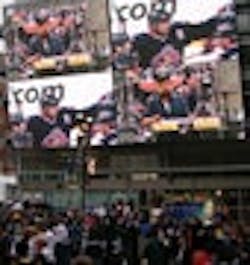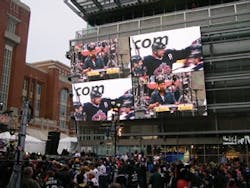64 Tons of Video Screen on the Move
At Victory Park Plaza in Dallas, eight 15x26-ft, 8-ton high-definition LED video walls move in synchronized motion. The Victory Media Network (VMN) project was created as an environment where video artists would have a continuous forum for their art.
What makes this motion control system unique is the video artist’s ability to program the motion of the 64 tons of video screens and synchronize them to the videos that they create.
“The original concept called for only 12 predefined motions, which would have been quite simple,” says Curt Peterson, president of Deterministic Systems (DSi) in Walnut Creek, Calif. “It was later decided that the artists should be able to program the motion of the screens synchronized to the videos they create. They wanted to create a whole new form of artistic expression combining video art and large screen motion.”
Peterson, who designed the screen motion system, knew this would add dynamic complexity to the control system. Now he had to create a motion script language to run on a PC simulator and then send that script file dynamically, so it would run on the big screens in real time. This meant DSi would have to create a motion script interpreter running real-time on each screen’s receiving PLC that would precisely execute the synchronized motion commands.
Videos in Motion
PLCs control eight video screens, each weighing 8 tons, that move on rails around Dallas’ Victory Park Plaza.
Photo source: Barco
So Peterson’s team created a PC-based simulator that allows the artists to create, edit and preview the motions of the video screens synchronized to the video content they created.
“The artists drag the screens around on their PC and then click when they want to create a cue while watching their videos run in the eight simulated screens,” says Peterson.
Barco Media of Belgium provided the video screens and selected Peterson and DSi for the project based in part on Peterson’s reputation for controlling large objects at high speeds—namely launching roller coasters. “We were the first to break the 100-mph barrier with a roller coaster,” says Peterson. “I guess you could say moving large objects is what attracted me to control systems as a profession.”
The eight LED walls are installed in two four-panel groups that face each other across the 60-ft-wide, 220-ft-long plaza. Two screens are mounted on each of four separate rails. Each screen moves on a horizontal axis of motion.
Two screens share a common rail but never come in contact, even though they are required to travel at 4 ft/sec with 2 in. of separation. “That’s 41mS of separation in time,” says Peterson. Absolute positioning is important because the two screens on the upper rail must align vertically to the two screens on the lower rail when combining to make a single display.
The walls are individually choreographed with separate video and surround-sound feeds. They may also be locked together to form 30x50-ft HD screens with true 16:9 aspect ratios. The entire project uses 4 million individual new-technology OLite surface-mounted LEDs, each with a capability of 185 trillion colors.
A motion control system manufactured by Siemens Energy & Automation and supplied by Buckles-Smith Electric moves the video walls according to pre-programmed motion profiles that are dynamically and continuously downloaded into a PLC located on each of the eight media walls. The show controller sends commands to the system PC.
The motor drive and positioning control system on each video screen receives and executes motion commands. On each of the eight screens is an onboard PLC that controls the communications and coordinated motions of the screen via Profibus. There are two Simovert Masterdrives vector control (VC) drives to control the two motors. Encoders on the motor shafts provide closed-loop velocity and position feedback. Because there is limited service access to the screens, they must be able to move back to the service position on the track with a single drive or motor failure. Absolute position of each screen is referenced from a fixed home target located on the track.
Safety was incorporated into the design at many levels. Each screen on the same rail can stop the other screen on the same rail by turning off a hardware output that controls the motor isolation contactors on its partner screen. If a drive fault occurs, master and partner communications stop the entire rail, enabling the remaining three rails to keep running. The master PLC supervises all of the motions of all of the screens and can also stop any screen by turning off a hardware output.
Any interruption in continuous communications from the master PLC to the eight screens and between partner screens causes the screens on a rail to stop. All six emergency stop pushbuttons distributed throughout the system stop motion on all eight screens. There is a portable color touchscreen HMI that plugs in at each of the four rails and allows local control of the screens. The system computer has a runtime WinCC that acts as the HMI for the operations and maintenance personnel.


